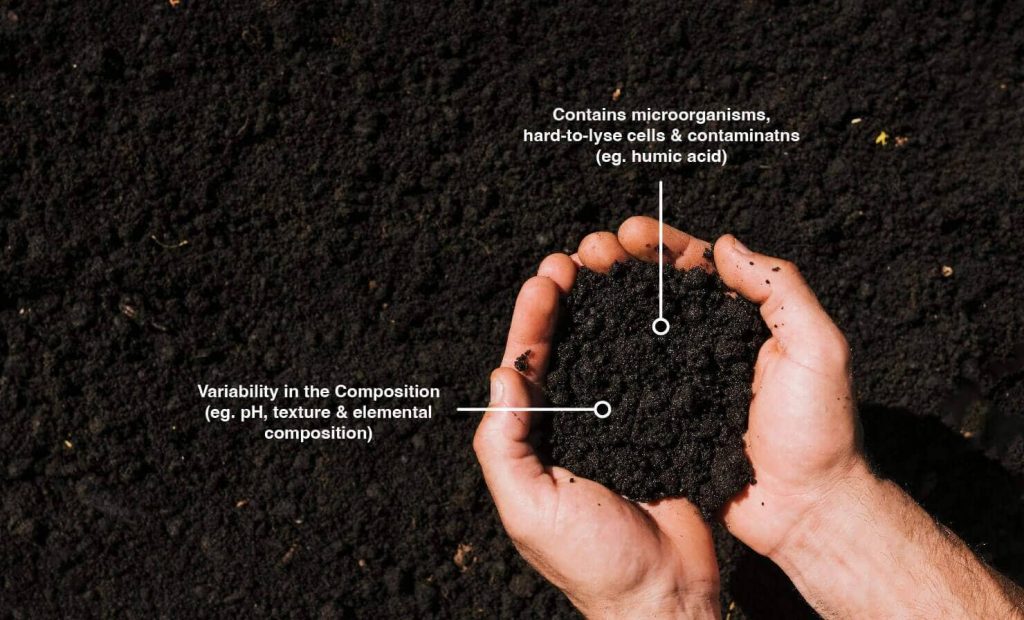DNA Extraction from Environmental Samples
Factors Affecting DNA Extraction from Environmental Samples

Image source: https://www.freepik.com/photos/flat-lay
As you know, numerous factors could affect the quality of your DNA extraction from environmental samples. These factors are:
- Environmental samples contain a variety of microorganisms, hard-to-lyse cells and contaminants such as humic acid.
- The variability in the composition of environmental samples in terms of pH, texture and elemental composition.
And here’s the real question, how to improve the quality of DNA extraction from environmental samples? Let’s look at these 6 tips for good DNA extraction techniques.
Collect soil samples below a certain depth (3-5 cm)
If you are collecting soil samples for DNA extraction, make sure you collect them below a certain depth (3-5 cm).
Why?
There may not be enough living microbes on the soil surface for DNA extraction. In addition to that, due to the long exposure of soil surfaces to the sun, UV rays most likely have killed the microbes. Therefore, it is highly recommended to collect soil samples below a certain depth.
If you are collecting water samples, filtering them with filter paper may be necessary to concentrate microbes
In some conditions, the concentration of living microbes in water samples is low, and you will need a large volume of starting samples. If you are using a commercial kit, the starting volume is usually limited by the kit. In this case, you have to decrease the starting volume of the sample. Hence, to increase the concentration of living microbes in the limited volume, you have to concentrate the living microbes by filtering water samples with filter paper. By doing so, the microbes will be retained on the filter paper, and you can transfer the filtrate for DNA extraction.
Use guanidine (chaotropic salt) and silica purification strategy as a starting point for optimizing extraction conditions
Guanidine helps to purify nucleic acids from the complex mixture. Furthermore, it also has a high denaturing ability that protects nucleic acids from DNase and RNase-mediated degradation.
Store your sample at -20ºC
Low temperatures help to inhibit the growth of bacteria and prevent the degradation of genomic material by nucleases. If you have to transfer your sample from one place to another place, you can use a DNA preservation/stabilization reagent as well.
Remove humic acids and other PCR inhibitors from the sample
Humic acids have similar size and charge characteristics to DNA, resulting in their co-extraction and affecting downstream applications. The inhibitors removal system in the commercial kits like FastDNA™ Spin Kit for Soil helps to remove most of the humic acids and PCR inhibitors. Not to mention that it saves you a lot of time.
Use lysing beads to lyse the cells thoroughly for optimal release of DNA from the cells
Some bacteria or difficult-to-lyse cells are difficult to break down completely, resulting in a low yield of extracted DNA. With the help of lysing beads, you can accelerate your cell lysis process greatly. Besides, the shear force from the beads could lyse the cells thoroughly. As a result, the genomic material can be released to the fullest extent possible.
Conclusion
In summary, we have summarized the 6 tips for good DNA extraction from environmental samples below:
- Collect soil samples below a certain depth (3-5 cm).
- Filtering water samples with filter paper may be necessary to concentrate microbes.
- Use guanidine (chaotropic salt) and silica purification strategy.
- Store your sample at -20ºC.
- Remove humic acids and other PCR inhibitors from the sample.
- Use lysing beads to lyse the cells thoroughly for optimal release of DNA from the cells.
If you have more tips and tricks, you may share them in the comment section below. Or if you are facing any problems in DNA extraction, feel free to contact us, we’ll try our best to help you out!



